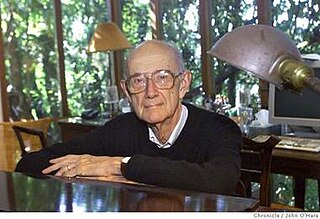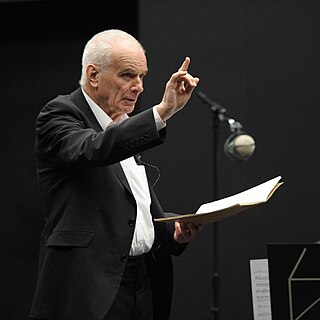Related Research Articles

Antal Doráti was a Hungarian-born conductor and composer who became a naturalized American citizen in 1943.

Roger Huntington Sessions was an American composer, teacher and writer on music.

Andrew Welsh Imbrie was an American contemporary classical music composer and pianist.

The cello suites by Benjamin Britten are a series of three compositions for solo cello, dedicated to Mstislav Rostropovich. The suites were the first original solo instrumental music that Britten wrote for and dedicated to Rostropovich, but Britten had earlier composed a cadenza for Joseph Haydn's Cello Concerto in C major, for Rostropovich, in 1964. Rostropovich gave the first performances of each work, and recorded Suites Nos 1 and 2 commercially.

Montezuma is an opera in three acts by the American composer Roger Sessions, with an English libretto by Giuseppe Antonio Borgese that incorporates bits of the Aztec language, Nahuatl, as well as Spanish, Latin, and French.
Alan Feinberg is an American classical pianist. He has premiered over 300 works by such composers as John Adams (composer), Milton Babbitt, John Harbison, Charles Ives, Steve Reich, and Charles Wuorinen, as well as the premiere of Mel Powell's Pulitzer Prize winning Duplicates. He is an experienced performer of both classical and contemporary music and is well known for recitals that pair old and new music.
Paul Rapoport is a Canadian musicologist, music critic, composer and professor at McMaster University in Hamilton, Ontario.
Iain Ellis Hamilton was a Scottish composer.
The Symphony No. 4 of Roger Sessions was composed in 1958.
The Symphony No. 5 of Roger Sessions was commissioned in 1960 and completed in 1964. It was commissioned by Eugene Ormandy and the Philadelphia Orchestra, and the first movement only was premiered by them in February 1964, the rest not being completed until that December.
The Symphony No. 2 of Roger Sessions was begun in 1944 and completed in 1946.
The Symphony No. 3 of Roger Sessions was written in 1957. It was a result of a commission by the Koussevitzky Foundation to celebrate the 75th anniversary of the Boston Symphony Orchestra, and was premiered by the Boston Symphony on December 6, 1957, conducted by Charles Munch. Sessions later was commissioned by the Boston Symphony on their centenary, when he provided them with his Concerto for Orchestra. Andrea Olmstead describes all of Sessions's symphonies as "serious" and "funereal", with No. 3 being one of four with, "quiet reflective endings."
The Symphony No. 7 of Roger Sessions was written in 1967 for the 150th anniversary of the University of Michigan. It was premiered in Ann Arbor, Michigan, on October 1, 1967, by the Chicago Symphony Orchestra, conducted by Jean Martinon.
The Symphony No. 1 of Roger Sessions is a symphony in three movements, in E minor.
The Symphony No. 8 of Roger Sessions was composed in 1968.
Roger Sessions' Violin Concerto was composed between 1927 and 1935, and is scored for violin and orchestra.

The Symphony No. 1 by Peter Maxwell Davies was composed between 1973 and 1976, and is dedicated to Sir William Glock, "as a mark of friendship and of appreciation of his work for contemporary music in his years as music controller at the B.B.C.". It was commissioned by the Philharmonia Orchestra, which gave the premiere of the symphony at the Royal Festival Hall, London, on 2 February 1978, with Simon Rattle conducting.
Tamara Brooks was an American choral conductor.
The Concerto for Orchestra is a composition for orchestra by the American composer Roger Sessions. The work was commissioned by the Boston Symphony Orchestra and premiered October 23, 1981, with conductor Seiji Ozawa leading the Boston Symphony Orchestra. The concerto was Sessions's last orchestral composition and won him the 1982 Pulitzer Prize for Music. Sessions had previously won a special lifetime achievement Pulitzer Prize in 1974 "for his life's work as a distinguished American composer." The piece was honored with a performance at the closing of the 50th Tanglewood Music Festival in 2014.
The Symphony No. 9 by Roger Sessions is a symphony in three movements, completed in 1978. A performance lasts about 28 minutes.
References
- ↑ Andrea Olmstead, Roger Sessions: A Biography (New York: Routledge, 2008): 358.
- 1 2 Roger Sessions, Symphony No. 6 (Bryn Mawr, PA: Merion Music, Inc., 1975): 1.
- ↑ Andrea Olmstead, "Roger Sessions Symphonies 6, 7 & 9", booklet accompanying CD recording, Roger Sessions Symphonies 6, 7 & 9, 3–5. Argo 444 519-2 (London: The Decca Record Company Limited, 1995): 3.
- ↑ "News Section". Tempo . New Series (121): 49. June 1977. ISSN 0040-2982. OCLC 1767255.; Andrea Olmstead, Roger Sessions: A Biography (New York: Routledge, 2008): 347, 357. ISBN 978-0-415-97713-5 (cloth); ISBN 978-0-415-97714-2 (pbk); ISBN 978-0-203-93147-9 (ebook). However, an anonymous item, "Concerts Mark Sessions' 70th", in Billboard (December 24, 1966): 41, states "Last month [i.e., November 1966], the first complete performance of his 'Symphony No. 6' was given by the New Jersey Symphony."
- ↑ Richard Swift (December 1976). "Symphony no. 6 (1966) by Roger Sessions; Symphony no. 8, op. 106 by Vincent Persichetti". Notes. Second Series. 33 (2): 406–407. doi:10.2307/897603. ISSN 0027-4380. JSTOR 897603. OCLC 45595520.(subscription required)
- ↑ Symphony No. 6: Roger Sessions: Rental (Bryn Mawr, PA: Theodore Presser Co.)
- ↑ "Track listing for the Argo Recording of Symphonies 6, 7 and 9" (in Japanese). Archived from the original on February 10, 2009. Retrieved 8 May 2009.
- ↑ Opening is quoted as example 7 in Imbrie. Imbrie, Andrew (1972). "The Symphonies of Roger Sessions". Tempo. New Series (103): 24–32. ISSN 0040-2982. JSTOR 943951. OCLC 1767255.(subscription required)
- ↑ Andrea Olmstead, Roger Sessions: A Biography (New York: Routledge, 2012): 356. ISBN 9781135868925.
- ↑ Richard Swift, "Symphony no. 6 (1966) by Roger Sessions; Symphony no. 8, op. 106 by Vincent Persichetti", Notes (second series) 33, no. 2 [ full citation needed ]:406–407. Citation on 407.